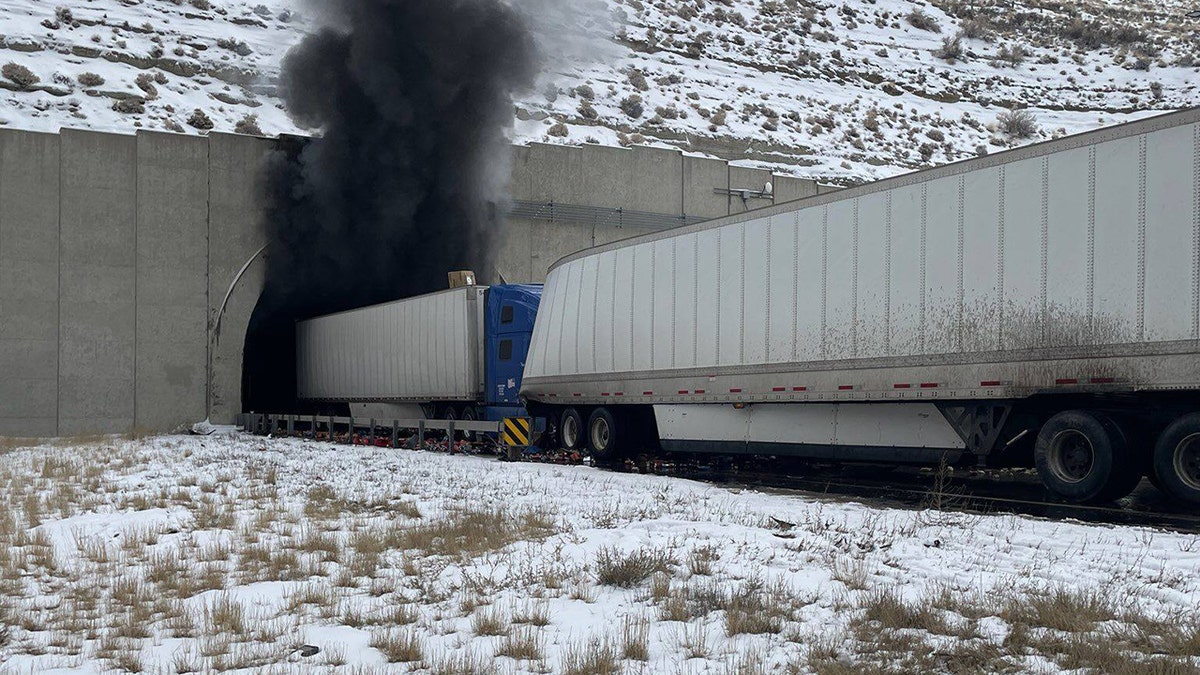Wyoming Tunnel Crash: A Closer Look At The Incident That Shocked The Nation
When news of the Wyoming tunnel crash broke, it sent shockwaves through the country. The incident quickly became a focal point for discussions about infrastructure safety and emergency response systems. As details unfolded, people began to realize just how significant this event was in shaping future policies. This wasn't just an accident—it was a wake-up call for everyone involved.
You know those moments when you hear something so intense that it stops you dead in your tracks? That’s exactly what happened when news outlets reported on the Wyoming tunnel crash. It wasn’t just another accident; it was a turning point that forced authorities and citizens alike to rethink how we approach transportation safety.
Now, before we dive deep into the nitty-gritty of this story, let’s set the stage. The Wyoming tunnel crash wasn’t just about a single event—it’s part of a larger conversation about infrastructure, technology, and human error. Stick around, because we’re about to break it all down for you.
Read also:Hyungry Temporary Replacement 3 The Ultimate Guide For 2023
Understanding the Wyoming Tunnel Crash
So, what exactly happened during the Wyoming tunnel crash? To put it simply, it was a catastrophic event where multiple vehicles collided inside a tunnel near Cheyenne, Wyoming. The aftermath was devastating, leaving many injured and several dead. But here’s the thing—this wasn’t just some random accident. There were underlying factors that contributed to the chaos.
Key Details About the Incident
Let’s get into the specifics. The crash occurred on a Friday evening during rush hour, which made matters worse. Emergency responders were faced with limited visibility and confined spaces, making rescue operations incredibly challenging. Here’s a quick rundown of what went down:
- Multiple vehicles were involved, including trucks and passenger cars.
- Fire broke out shortly after the initial impact, complicating rescue efforts.
- Communication between emergency teams was strained due to poor signal in the tunnel.
It’s worth noting that the tunnel itself had been flagged for maintenance issues in the past. Some experts believe that these pre-existing problems played a role in the severity of the crash.
Causes Behind the Wyoming Tunnel Crash
Now, let’s talk about the causes. Was it human error? Mechanical failure? Or maybe a combination of both? Turns out, it was a little bit of everything. Investigations revealed several contributing factors that led to the disaster.
Human Error vs. Infrastructure Issues
First off, there were reports of reckless driving leading up to the crash. Witnesses claimed they saw one of the drivers speeding dangerously close to other vehicles. On top of that, the tunnel’s structural integrity came under scrutiny. Engineers pointed out that the ventilation system wasn’t functioning properly, which exacerbated the fire and smoke situation.
Here’s the kicker—some experts argue that better signage and clearer lane markings could have prevented the accident altogether. It’s like they say, “An ounce of prevention is worth a pound of cure.”
Read also:Wyandotte Boat Ramp Your Ultimate Guide To Navigating The Waterways
Impact on the Community
The Wyoming tunnel crash didn’t just affect those directly involved. It left a lasting impact on the entire community. Families were left grieving, businesses suffered losses, and trust in local infrastructure took a major hit. People started asking tough questions about safety standards and accountability.
Emotional Toll on Survivors
For the survivors, the trauma of the crash will stay with them for a long time. Imagine being trapped in a dark tunnel with smoke filling the air. It’s a nightmare no one should have to experience. Support groups sprang up almost immediately to help victims cope with the emotional aftermath.
Local mental health professionals reported an increase in patients seeking counseling following the incident. It just goes to show how deeply such events can affect people’s lives.
Emergency Response and Rescue Efforts
When disaster strikes, the first responders are the real heroes. In the case of the Wyoming tunnel crash, emergency teams faced immense challenges. Limited access, thick smoke, and the risk of secondary explosions made their job incredibly difficult. Yet, they managed to save countless lives despite the odds.
Lessons Learned from the Rescue Operation
One of the key takeaways from the rescue operation was the importance of communication. Poor cell phone reception inside the tunnel hampered coordination efforts. Moving forward, experts recommend installing better communication systems in tunnels across the country.
Additionally, training programs for emergency personnel need to incorporate more scenarios involving confined spaces and hazardous materials. It’s all about being prepared for the unexpected.
Government Response and Policy Changes
After the dust settled, government officials couldn’t ignore the glaring issues exposed by the Wyoming tunnel crash. They quickly moved to address concerns about infrastructure safety and emergency preparedness. New policies and regulations were proposed to prevent similar incidents in the future.
Proposed Solutions for Tunnel Safety
Some of the proposed solutions include:
- Regular inspections and maintenance of tunnels.
- Installation of advanced fire suppression systems.
- Improved signage and lane markings to reduce confusion.
While these measures won’t bring back those who lost their lives, they can help prevent future tragedies. It’s a step in the right direction.
Public Reaction and Media Coverage
As you might expect, the public reaction to the Wyoming tunnel crash was intense. Social media exploded with posts and discussions about the incident. Journalists from around the world descended on Wyoming to cover the story, turning it into a global news event.
How the Media Shaped the Narrative
Media coverage played a crucial role in shaping public perception of the crash. Some outlets focused on the human stories behind the tragedy, while others emphasized the systemic failures that allowed it to happen. This diverse coverage helped bring attention to important issues that might otherwise have been overlooked.
However, not all media coverage was constructive. Sensationalist reporting sometimes overshadowed the facts, leading to misinformation and confusion. It’s a reminder of the importance of responsible journalism in times of crisis.
Technological Advancements in Tunnel Safety
With each tragedy comes an opportunity for growth. The Wyoming tunnel crash acted as a catalyst for technological advancements in tunnel safety. Innovations in sensors, communication systems, and emergency response tools are already being developed to mitigate risks.
Emerging Technologies for Safer Tunnels
Here are a few examples of emerging technologies:
- Smart sensors that detect potential hazards in real-time.
- Augmented reality systems to assist emergency responders.
- Automated systems for controlling traffic flow in tunnels.
These advancements won’t eliminate all risks, but they’ll certainly make tunnels safer for everyone. It’s exciting to see how technology is being used to solve real-world problems.
Long-Term Implications for Infrastructure
The Wyoming tunnel crash highlighted the need for a comprehensive approach to infrastructure management. It’s not enough to fix individual issues as they arise; there needs to be a strategic plan for maintaining and upgrading critical infrastructure nationwide.
Investing in the Future
Experts agree that investing in infrastructure now will save money and lives in the long run. Governments and private companies need to work together to ensure that tunnels, bridges, and roads are safe for everyone. It’s a commitment to the future that we can’t afford to ignore.
Think of it like this—if you neglect your car’s maintenance, it’ll eventually break down. The same principle applies to infrastructure. Regular care and attention are essential for longevity and safety.
Personal Stories from the Crash
Behind every statistic is a personal story. The Wyoming tunnel crash was no exception. Survivors and families of victims shared their experiences, bringing a human element to the tragedy. Their stories serve as a powerful reminder of why safety matters.
Voices from the Scene
One survivor described the moment the crash happened as “surreal.” Another talked about the bravery of the first responders who risked their lives to save others. These narratives add depth to our understanding of the event and inspire us to take action.
Listening to these stories can be heartbreaking, but they also offer hope. They show us that even in the darkest times, there’s light to be found in the actions of good people.
Conclusion: Moving Forward After the Wyoming Tunnel Crash
As we reflect on the Wyoming tunnel crash, it’s clear that this was more than just an accident. It was a wake-up call for everyone involved in infrastructure management and emergency response. By learning from this tragedy, we can create a safer future for generations to come.
We urge you to share this article with others and start conversations about infrastructure safety. Together, we can make a difference. And remember, if you have any thoughts or questions, feel free to leave a comment below. Let’s keep the dialogue going!
Table of Contents
- Understanding the Wyoming Tunnel Crash
- Key Details About the Incident
- Causes Behind the Wyoming Tunnel Crash
- Human Error vs. Infrastructure Issues
- Impact on the Community
- Emotional Toll on Survivors
- Emergency Response and Rescue Efforts
- Lessons Learned from the Rescue Operation
- Government Response and Policy Changes
- Proposed Solutions for Tunnel Safety
- Public Reaction and Media Coverage
- How the Media Shaped the Narrative


